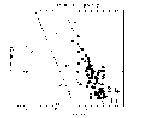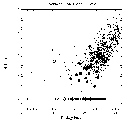The SSC
XID Programme
The follow-up
and identification (XID) programme is an integral part of the tasks that
the XMM Survey
Science Centre has been committed to carry out for the benefit of the
community.
This
will be achieved by means of a core
programme (CP), in which large unbiased samples of X-ray sources will
be constructed and followed up with optical and IR spectroscopy, and by
simultaneously carrying out an imaging
programme (IP) in which a large fraction of the EPIC images will be
imaged in several optical and near infrared colours to facilitate the identification
of X-ray sources in probabilistic terms, making joint use of X-ray and
optical data.
The
faintest sources that the XMM serendipitous survey will contain (with X-ray
fluxes ~ 10-15erg cm-2 s-1) are expected to have optical magnitudes R ~24-25.
From
soft X-ray surveys carried out with ROSAT
we would expect the magnitude of unobscured objects at that X-ray flux
level to be around 23-24 (see graph 1), but the fact that XMM is sensitive
to hard X-rays means that a significant fraction of the objects will be
obscured and optically fainter.
In
practice this means that the spectroscopic identification of the faintest
sources will require the use of optical and infrared spectrographs on 8-10m
class telescopes.
 Figure 1: Soft X-ray flux versus R magnitude for the ROSAT Lockman Hole
deep survey.
Figure 1: Soft X-ray flux versus R magnitude for the ROSAT Lockman Hole
deep survey.
The
ROSAT Lockman Hole survey also shows that fainter X-ray sources are redder,
even when selected at soft X-ray energies (see graph 2). This is consistent
with greater extinction along the line of sight (Hasinger et al 1999).
 Figure 2: Colours of the optical counterparts of the ROSAT Lockman Hole
deep survey sources.
Figure 2: Colours of the optical counterparts of the ROSAT Lockman Hole
deep survey sources.
However
this is only one part of the serendipitous sample that XMM will provide.
Currently the faintest measured sources in hard X-rays have 2-10 keV fluxes
higher than 10-14erg cm-2 s-1 (Georgantopoulos
et al 1997) and only a handful of are identified. The situation is little
better at fluxes ~10-13 erg cm-2 s-1,
with less than 100 sources identified so far. Therefore there is a wide
range in flux to be explored with the use of the XMM serendipitous survey,
a large fraction of which relates to sources with optical magnitudes appropriate
for 2m and 4m class telescopes.
Last modified
10th March 2000
Text based on
AXIS proposal by X.Barcons and the SSC consortium.
Page designed
by J.Verdon and maintained by www_astro@mssl.ucl.ac.uk
 Figure 1: Soft X-ray flux versus R magnitude for the ROSAT Lockman Hole
deep survey.
Figure 1: Soft X-ray flux versus R magnitude for the ROSAT Lockman Hole
deep survey.
